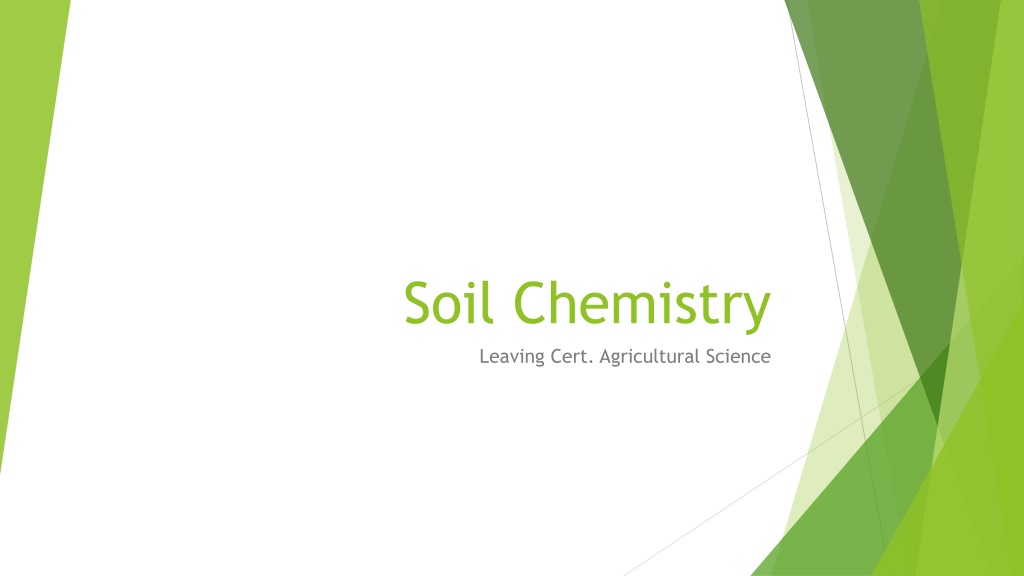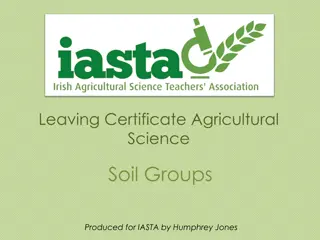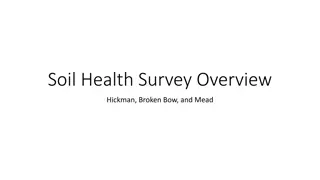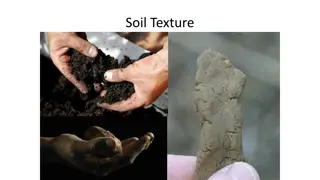Understanding Soil Chemistry in Agricultural Science
Explore the role of soil colloids and cations in agricultural science, how opposites attract to form floccules, and the impact of cation exchange on soil fertility through liming. Gain insights into the processes that influence soil nutrient availability and plant growth.
Download Presentation

Please find below an Image/Link to download the presentation.
The content on the website is provided AS IS for your information and personal use only. It may not be sold, licensed, or shared on other websites without obtaining consent from the author. Download presentation by click this link. If you encounter any issues during the download, it is possible that the publisher has removed the file from their server.
E N D
Presentation Transcript
Soil Chemistry Leaving Cert. Agricultural Science
Soil Colloids Negatively charged (can attract something positive because opposites attract) Colloid is a collective term for Clay (Mineral) and Humus (Organic) particles.
Cations + Water = Polarised water Farmers often treat soil with lime or fertiliser. Both of these dissolve in water. When they dissolve in water the positively charged parts of the lime/fertiliser, called ions, make the water positive as well. A positively charged ion is called a Cation. Cations can attract negatively charged particles. Water that contains a number of cations is called polarised water, meaning it contains ions such as NH4+K+Ca2+ and Mg2+
Opposites attract! Remember the soil colloids, clay or humus particles are negatively charged, it will pull the polarised water towards it, the water then contains all of the ions (nutrients). What you notice in the sketch above are two colloids that joined by polarised water. The polarised water links them together.
Floccules When colloids stick together with polarised water they create a chain. This small chain is called a floccule. Floccules improve soils by increasing the pore space, improving aeration, drainage, and soil temperature. If a floccule gets big enough it can trap other particles like sand, silt, and clay. When this occurs it becomes known as an aggregate or ped.
Cation Exchange Definition: Cation Exchange (CE) Is the swapping of cations on the surface of colloids. Cations will swap places with each other for a number of reasons, one of those reasons is if the concentration of one is higher, then it will swap or displace another element with ease. Basically because there is more of one, they will remove the other ion from the other cation. CE can also take place between water as it flows through the soil, and plant roots. Roots will take the nutrients from a soil using CE. Looking at the sketch above, a colloid will become surrounded in H+overtime (becoming infertile).
Liming (Cation Exchange) When a colloid is surrounded by H+ions it is infertile as plants do not want them. The soil is said to be acidic because H+ determine the acidity of a soil. Spreading Lime introduces new ions in high concentrations which will displace the H+from the colloids and swap into the water which will travel to lower horizons.
Soil Water Capillary water exists in the spaces between the soil particles which we call soil pores. This water is readily available for plants to uptake. The polarised water that is attracted to the colloids is not available for plants, the force of attraction is too strong for plants to access it. This water is called hydroscopic water. When a soil is at permanent wilting point, this is the only water remaining in the soil.























